2.4 Solving Using the Square Root Method
2.4.1 Preview
Example
The graph of [latex]f\left(x\right)=x^2-9[/latex] is given. Notice the graph has symmetry over the y-axis and that the x-intercepts, (-3,0) and (3,0), are also symmetric.
[latex]\begin{array}{rcl}f(x)&=&x^2-9\\x^2-9&=&0\\x^2-\cancel9+\cancel9&=&0+9\\x^2&=&9\\\sqrt{x^2}&=&\sqrt9\\\vert x\vert&=&3\\x&=&\pm3\end{array}[/latex]
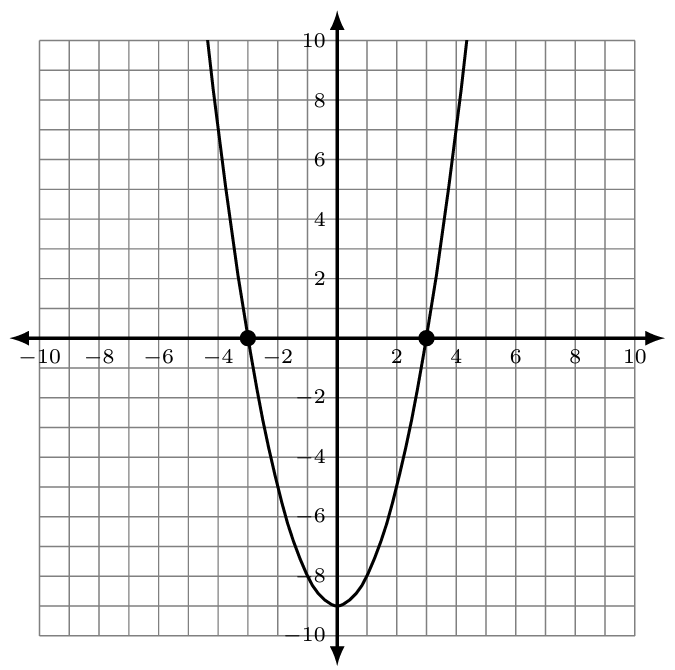
Example
The graph of [latex]f\left(x\right)=9-4x^2[/latex] is given. Notice the graph has symmetry over the y-axis and that the x-intercepts are also symmetric.
[latex]\begin{array}{rcl}f(x)&=&9-4x^2\\9-4x^2&=&0\\9-\cancel{\mathcal4\mathcal x^{\mathcal2}}+\cancel{\mathcal4\mathcal x^{\mathcal2}}&=&0+4x^2\\9&=&4x^2\\\frac94&=&x^2\\\sqrt{\frac94}&=&\sqrt{x^2}\\\frac32&=&\vert x\vert\\\pm\frac32&=&x\end{array}[/latex]
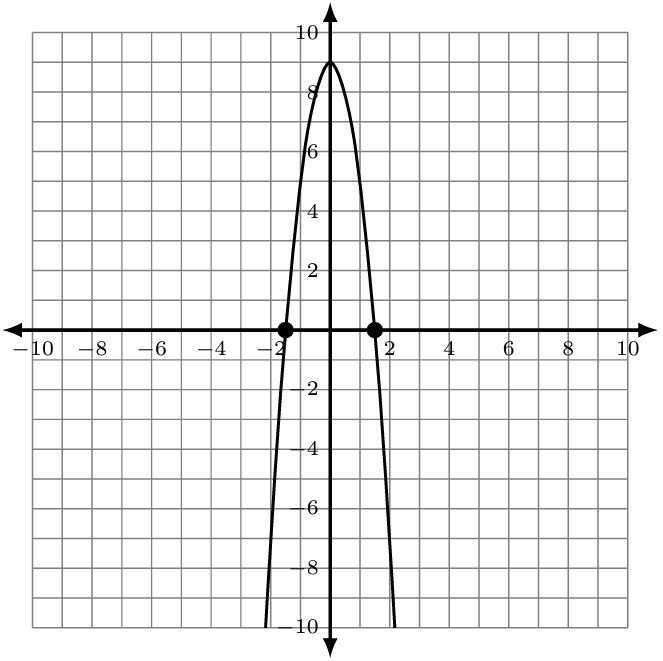
Example
The graph of [latex]f\left(x\right)=x^2-12[/latex] given. Notice the graph has symmetry over the y-axis and that the x-intercepts are also symmetric.
[latex]\begin{array}{rclc}f(x)&=&x^2-12&{}\\x^2-12&=&0&{}\\x^2-\cancel{12}+\cancel{12}&=&0+12&{}\\x^2&=&12&{}\\\sqrt{x^2}&=&\sqrt{12}&{}\\\vert x\vert&=&2\sqrt3&{}\\x&=&\pm2\sqrt3&(\mathrm{exact})\\x&\approx&\pm3.464&(\mathrm{approximate})\end{array}[/latex]

Example
The graph of [latex]f\left(x\right)=x^2+4[/latex] given. Notice the graph has symmetry over the y-axis, but it has no x-intercepts.
[latex]\begin{array}{rcl}f(x)&=&x^2+4\\x^2+4&=&0\\x^2+\cancel4-\cancel4&=&0-4\\x^2&=&-4\\\sqrt{x^2}&=&\sqrt{-4}\\\vert x\vert&=&2i\\x&=&\pm2i\end{array}[/latex]
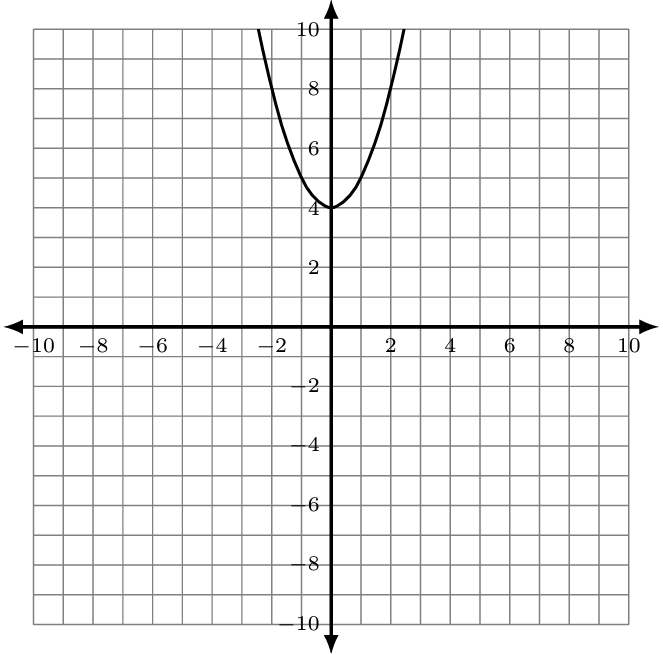
2.4.2 Classwork
Solve using the Square Root Method.
- [latex]x^2-16=0[/latex]
- [latex]x^2-100=0[/latex]
- [latex]x^2+25=0[/latex]
- [latex]x^2+88=7[/latex]
- [latex]x^2+7=4[/latex]
- [latex]x^2-4=-5[/latex]
- [latex]6x^2=90[/latex]
- [latex]99-4x^2=0[/latex]
- [latex]\frac34x^2=12[/latex]
- [latex]49x^2+16=8[/latex]
- [latex]x^2+5=17[/latex]
- [latex]x^2-41=0[/latex]
- [latex]-8x^2-6=-30[/latex]
- [latex]x^2-17=6[/latex]
- [latex]\frac12x^2-29=3[/latex]
- [latex]\frac34x^2+\frac13=0[/latex]
Answer the following.
- In science class, students were asked to create a container to hold an egg which they would then drop from a window. The function [latex]h\left(t\right)=-16t^2+25[/latex] gives the container’s height h (in feet) after t seconds. How many seconds will it take for the container to hit the ground?
- Use the equation [latex]9x^2-5=0[/latex] to answer the following.
- Solve using the Quadratic Formula.
- Solve using the Square Root Method.
- Discuss the differences between (a) and (b). State which method you prefer and why.
- Under what conditions for [latex]ax^2+bx+c=0[/latex] can you solve using the Square Root Method? Explain.
- For which of the following graphs could you use the Square Root Method to solve for the x-intercepts? Explain.
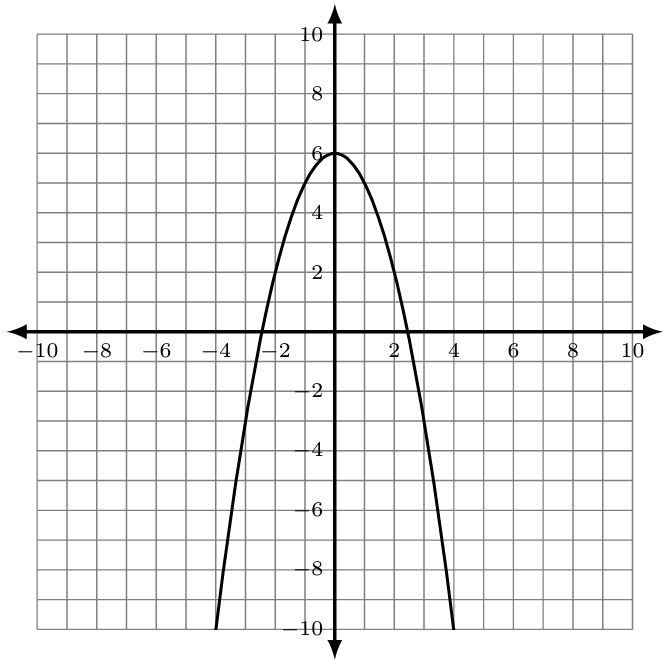
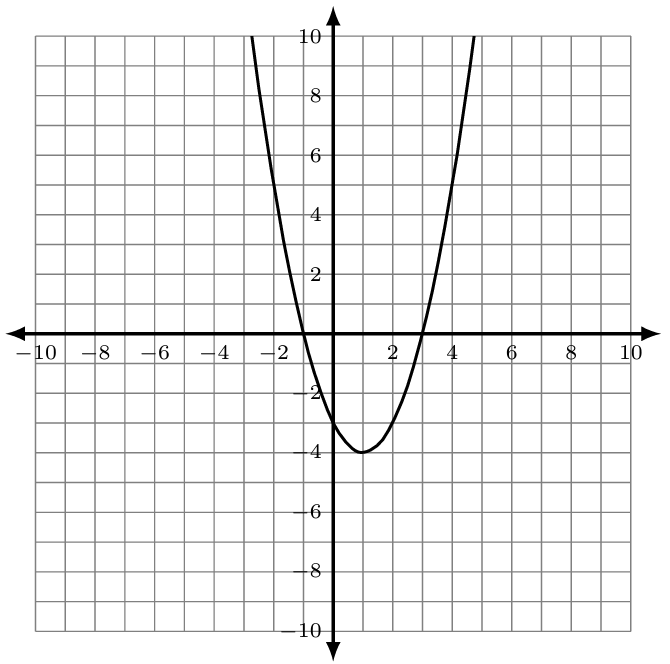
2.4.3 Homework
- Compare and contrast [latex]f\left(x\right)=x^2-4\;\text{and}\;\;\;g\left(x\right)=x^2+4.[/latex]
Solve using the Square Root Method.
- [latex]x^2-49=0[/latex]
- [latex]2x^2-6=0[/latex]
- [latex]5x^2+20=0[/latex]
- [latex]4x^2+81=0[/latex]
- [latex]\frac1{10}x^2-\frac{23}5=0[/latex]
- [latex]\frac13x^2+\frac14=\frac{115}{12}[/latex]
Graph and identify the following characteristics for the function.
-
[latex]g\left(x\right)=4x^2-5[/latex]
Opens: Up / Down
Axis of Symmetry:
Vertex:
y-intercept:
x-intercept(s):
Domain:
Range:
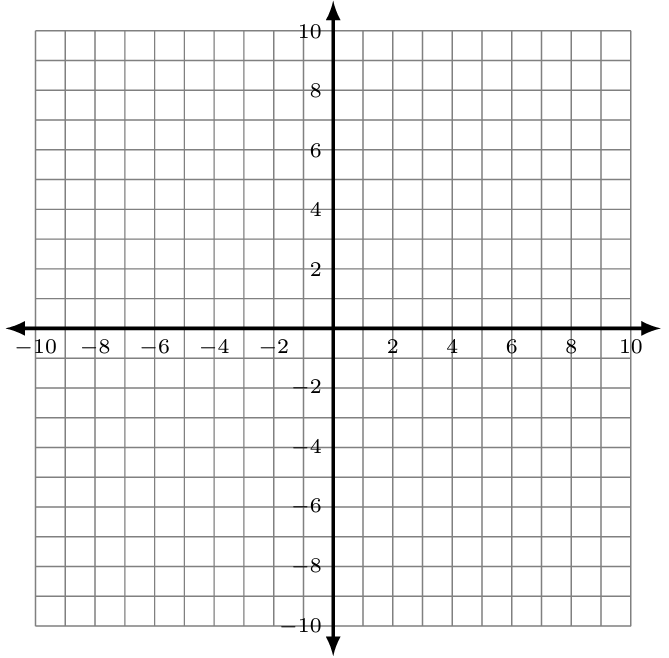
Answer the following.
- The Apollo’s Chariot is a rollercoaster at Busch Gardens with a top speed of 117 km/hr. Its initial (and tallest) descent can be modeled by [latex]h\left(t\right)=52-4.9t^2[/latex], where h is in meters and t is in seconds. How long does it take to reach the bottom of the hill?
- Create a quadratic equation with solutions [latex]x=\pm\sqrt5[/latex]
- Revisit problem 1, and expand on your previous answer using what you have practiced over solving and graphing in this section.

